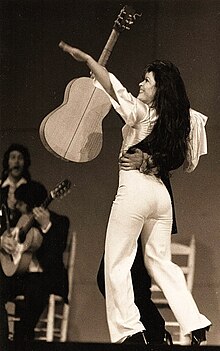Antoñita Singla
Antoñita Singla (born 1948)[1] is a Spanish-born Romani flamenco dancer and actress. She often went by the stage name Antoñita La Singla or simply "La Singla".
Early life[edit]
Antonia Singla Contreras was born in 1948 in the neighborhood Somorrostro de la Barceloneta, in Barcelona, Spain.[2] At the time of her birth, this neighborhood was a shanty town and a Romani community.[3] A few days after her birth she was in pain, perhaps caused by meningitis, and lost her hearing.[2] In 1968, she made a partial recovery from her medical condition.[1] While she was growing up, La Singla learned to dance rumba, fandango, bulerías and flamenco with considerable skill.[4] Singla began to dance by watching her mother clapping, absorbing the rhythm and turning it into a really remarkable dance full of emotions. It is said that she did not speak fluently until the age of 16.[4]
Career[edit]

Singla began her career at the early age of 12, dancing in some taverns in Barcelona. She was known for wearing pants in a bailaor style when performing dramatic dancing, something also done by Carmen Amaya and a few other flamenco dancers before her.[5][6]
In 1960, she launched her artistic career by participating in the group project Festival Flamenco Gitano[7] in which personalities such as Paco de Lucía, Camarón de la Isla, and El Faraón, among others, participated.[citation needed] This 1965 event was the brainchild of German organizers of Blues and Gospel festivals, who decided to invest in flamenco, later participating in numerous television programs. In addition, the Festival Flamenco Gitano toured Europe and the American continent. The first performance took place in the German capital, Berlin. La Singla was more famous internationally than in Spain.[5]
In 1963, she performed as an actress and dancer in the film Los Tarantos, directed by Francisco Rovira-Beleta. The film is based on a play by Alfredo Mañas and tells the story of the fierce confrontation between two Roma families in Barcelona: "Los Tarantos" and "Los Zorongos". Antoñita La Singla participated in the film as 'Sole', one of the dancers. In addition, thanks to the filming of the movie, Singla was able to meet Carmen Amaya,[1] with whom she was compared too. The film, Los Tarantos was nominated for an Academy Award in 1964 for "Best Foreign Language Film".
Another important milestone in the career of Antoñita Singla was her performance in the flamenco club Los Califas, a 1964 flamenco club whose tablao flamenco was inaugurated on October 15, 1965.[citation needed] The club owners heard about her through the artistic manager Antonio Fernández. A few days later she traveled to Madrid ready to debut in "Los Califas".[8] Obviously, it was not easy to accompany "La Singla", since she lacked the hearing and speech needed to interact with the musicians. Nevertheless she flawlessly executed the performance in its entirety. It was this unusual situation that drew professionals from the flamenco dance community to the Los Califas dance club.[8]
Legacy[edit]
As of 2017, Singla lives in Santa Coloma de Gramenet,[9] in Catalonia, Spain far from the tablaos.
On April 15, 2017, one of the brothers of the artist, Juan José Singla Contreras, and his partner, Santiago Parra, opened a flamenco tablao[10] in Barcelona with the name of La Singla to pay tribute. The location of La Singla is located in front of La Monumental bullring, and it is the first new flamenco establishment that has opened in the city in 30 years.[9]
References[edit]
- ^ a b c Leblon, Bernard (2003) [1995]. Gypsies and Flamenco: The Emergence of the Art of Flamenco in Andalusia. Great Britain: Univ of Hertfordshire Press. ISBN 1902806050.
- ^ a b El Arte de Vivir el Flamenco, ed. (2003). "ANTOÑITA LA SINGLA" (in Spanish). Retrieved 6 May 2018.
- ^ Vila, M. (2017-05-24). "Shantytowns in Barcelona: in the shadows of history". EL PAÍS. Retrieved 2019-11-27.
- ^ a b Medicine Babe, Maverick (30 October 2012). "La Singla Antonita's miraculous story". Retrieved 6 May 2018.
- ^ a b Schreiner, Claus; Pauly, Reinhard G.; Claus, Madeleine (1990). Flamenco. Hal Leonard Corporation. pp. 117. ISBN 1574670131.
- ^ Ruiz, Ana. (2007). Vibrant Andalusia: The Spice of Life in Southern Spain. Algora Publishing. OCLC 939926357.
- ^ Lobatón, Fermín (7 January 2016). "El primer Festival Flamenco Gitano". El País (in Spanish). Retrieved 6 May 2018.
- ^ a b Banegas, Paco (4 April 2018). "ANTOÑITA LA SINGLA" (in Spanish). Retrieved 6 May 2018.
- ^ a b Merino, Olga (17 March 2017). "Del Somorrostro a l'Olympia" (in Spanish). Retrieved 6 May 2018.
- ^ Jorro, Ignasi (8 March 2017). "El nuevo templo del flamenco en la Cataluña del 'procés'" (in Spanish).
External links[edit]
- Video: 1960s Antonita Singla dancing at Festival Flamenco Gitano on YouTube
- Video: Fragment of Los Tarantos on YouTube
- Video: La Singla in the Feria on YouTube

